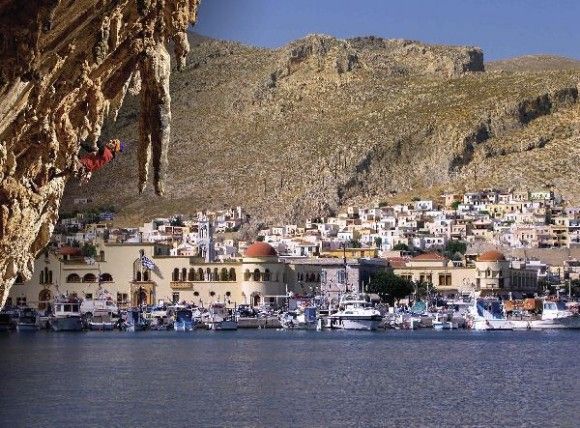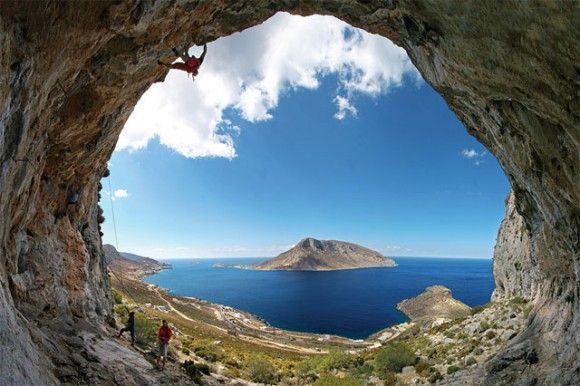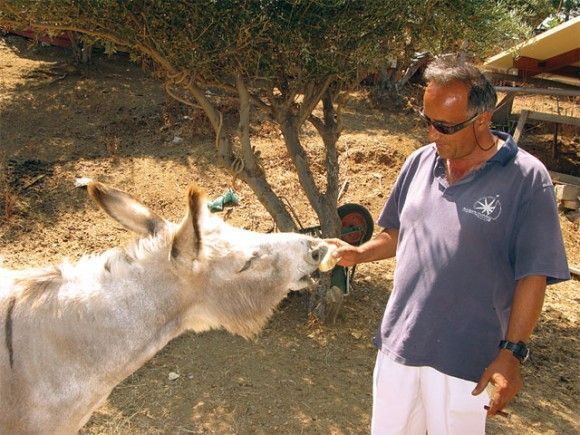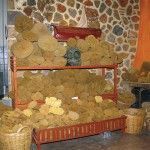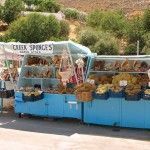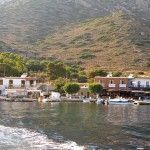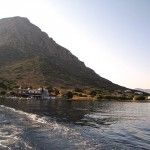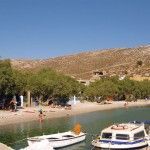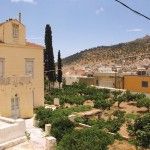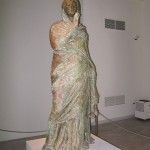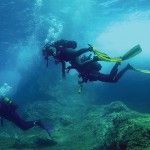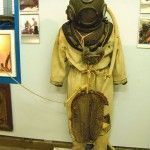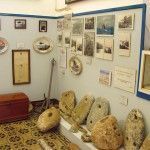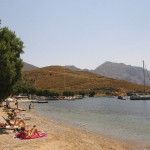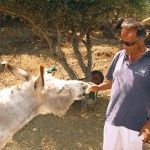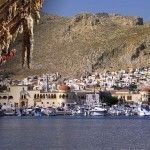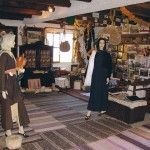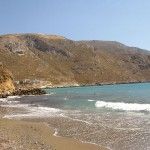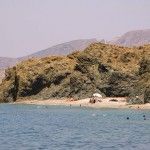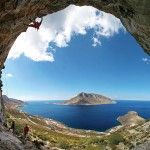Kalymnos… An Ideal Destination For All
Every Greek island has a special characteristic that works as an individual holiday attraction. What really makes a destination special is when that certain characteristic gains worldwide status… Kalymnos is considered one of the best destinations worldwide for rock climbing. It all began in 1996 when an Italian climber noticed the unique quality of the non-vegetated calcareous rocks and the overhangs and caves with stalactites.
The rest is history…
“It impresses us that rock climbers start out from faraway countries to come rock climbing on Kalymnos… We have welcomed visitors from the most unlikely countries such as China, Japan, New Zealand and Chile,” Nikolas Reisis, president of the Kalymnos Hoteliers Association, told GTP.
Within the framework of the “Kalymnos for All” low-cost vacation program, organized by the island’s hoteliers association, Mr. Reisis invited journalists to visit the island and experience Kalymnos first hand.
When entering the amphitheatrically shaped port (and capital) of the island, Pothia, the island’s unique appearance as an attractive blend of various architectural styles pops into view against a mountainous background.
The island’s mountainous nature is exactly what has put Kalymnos on the map as a popular rock climbing destination and has given the island publicity throughout the world.
Today Kalymnos sports 77 climbing fields and some 1,200 routes and is the third rock climbing destination on a global scale following Majorca (Spain) and Corsica (France). According to the locals, the best area for climbing is Armeos, near the resorts of Myrties and Massouri on the west coast.
What may impress visitors is the fact that Kalymnos can easily be recommended for all-year-round holidays, which is not the case for the majority of Greek islands.

The standard diving suit or Skafandro, which replaced the “skin diving” method, which was introduced in the mid 1800’s. Sponge diving brought wealth to the island but also caused casualties due to decompression sickness soon after the standard suit was introduced. According to research, between 1886 and 1910, some 10,000 divers died and 20,000 were disabled.
With a population of 17,000 locals, winter life on Kalymnos is vibrant and eventful as it is during the summer, as opposed to nearby popular islands that are not famous for wintertime life.
The island, situated between Kos and Leros, is the fourth largest island in the Dodekanissos complex and is best known as home of the world’s finest sponge divers.
The sponge fishing trade has shaped the island’s entire culture, something that is apparent almost everywhere on the island.
The tradition of sponge fishing is utilized today in a variety of ways.
As well, the island annually welcomes divers that either visit for recreation or for professional reasons as Kalymnos is also considered a place of importance when it comes to diving.
The Municipality of Kalymnos encourages diving and rock climbing by arranging an international rock climbing festival and diving festival every two years on the island.
In addition to rock climbing and diving, Kalymnos offers visitors a variety of alternative forms of tourism that include trekking, sailing and religious excursions.
The most popular churches of Kalymnos are Metamorphosis tou Sotiros in Pothia and Agios Panteleimonas that is built within a mountain cave.
Kalymnos boasts three museums devoted to archaeology, sponge diving history and folk art.
The island’s new Archaeological Museum is located in Pothia, in the Agia Triada district. The museum, which opened in 2009, features pieces from the Pre-Historic to the post-Byzantine eras.
Kalymnos’ rich history of seafaring and sponge diving can be experienced at the island’s Nautical Museum, home to the life of sponge divers and old shipwrecks. Incorporated within the premises is the Folklore Museum.
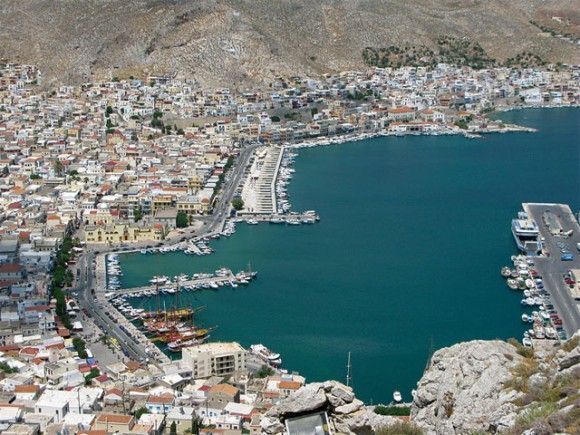
The Agios Savvas monastery is a must-see and dominates the west side of the harbor and offers magnificent views.
Also, architect lovers can find an exceptional example of 19th century urban architecture at the mansion of the Vouvali family that today operates as a museum.
When on Kalymnos daily excursions are a must. The island has many small towns and villages just waiting to be explored: Argos, Vlihadia, Emborios, Massouri, Myrties, Panormos and Skalia.
Also highly recommended are excursions to the populated nearby islets Telendos and Pserimos.
Until recently, access to Kalymnos proved difficult as routes from the central port of Piraeus had decreased to a point (last year) that the island was left with only two itineraries a week.
This summer, the sea connection from Piraeus improved with the addition of Kalymnos to the schedule of Blue Star ferries.
Those who prefer to arrive by air can do so via Kos Airport, as Kalymnos Airport is very small and does not accept charter flights. From Kos visitors board the Kalymnos Star speedboat from Mastihari Port and arrive shortly to Pothia Port on Kalymnos.
Tourism on Kalymnos
In regards to tourist traffic, Kalymnos once attracted a large crowd, something that has changed completely over the recent years.
“Tourism on Kalymnos has showed a steady decline over the past 10-15 years, as from 1,500 arrivals per week (1992-1994) we have reached 300 arrivals per week,” Vasilis Psarobas, managing director of Kalymnos Group Travel, told GTP.
However, Mr. Psarobas underlined that during the last three years Scandinavian tour operators have expressed an interest to increase ties with the island.
In regards to what type of tourism Kalymnos represents, Mr. Psarobas highlighted that the island can not draw mass tourism due to lack of infrastructure.
This is something that the Municipality of Kalymnos agrees to as well.
“We support and promote alternative forms of tourism (rock climbing, diving, religious excursions) as Kalymnos is not an island for mass tourism,” Irini Halkiti, president of the island’s municipal tourism committee, told GTP.
The island’s hoteliers and businessmen, however, disagree with the municipality’s outlook on what type of tourism Kalymnos should promote.
“Kalymnos is for both mass and alternative tourism,” said Nikolas Reisis, president of the Kalymnos Hoteliers Association. In his opinion the municipality “limits” the island’s potential by passing it off exclusively as an alternative tourism destination.
As for the local residents of Kalymnos, they have grasped the concept of tourism and treat each tourist as an individual.
“During the 70’s and 80’s Kalymnos was not interested in tourism like Kos and Rodos because of its huge income from the professions of sailors, fishermen and sponge divers,” he said.
“Now, however, if tourism disappears we will sink… Now it’s all about survival,” he concluded.
Kalymnos Sees Low 2010 Bookings
In regards to this year’s tourism season, the president of the Kalymnos Hoteliers Association, Nikolas Reisis, did not appear too optimistic especially in regards to domestic tourism.
The hotelier’s president told GTP that the Greek market was late in making bookings because the Workers’ Welfare Foundation’s social tourism program (subsidized holidays) made a late start.
Mr. Reisis added that hotel reservations were also low due to the fact that in general Greeks opt for last minute bookings.
“We are not at all satisfied from the Greek market and I don’t think we’ll see last year’s levels,” he stressed.
When questioned by GTP on the outcome of the “Kalymnos for All” program -an initiative of the island’s hoteliers to attract domestic tourism with very attractive accommodation prices if summer bookings were made in advance- Mr. Reisis said that it did not have the expected results.
“I believe the program was not a success due to that Greeks find it difficult to plan their holidays early, but at least the island was advertised and we laid out the groundwork for a possible continuation in the future,” he said.
Step Back In Time On Telendos
Just ten minutes away from the west coast of Kalymnos by boat, Telendos is considered a must-see destination when vacationing on Kalymnos.
Motor vehicles are prohibited on the isle, which is known for its peaceful beaches, gulfs and small harbors. The isle has 43 inhabitants during the winter months that are mainly occupied with fishing.
According to Giannis Galouzis, president of Telendos island cultural association, the tourism season begins April-May and runs until October.
The island is equipped with the basic amenities for tourists, as there are only 100 rooms (200 beds) available for accommodation.
Archaeological ruins are also found throughout Telendos, which was once part of Kalymnos until a massive earthquake in 535 A.D. separated it from the rest of the island. Frequent boat rides serve the transportation to and from Myrties.
- Nikolas Reisis, President of Kalymnos Hoteliers Association.
- Vathy or Rina village and port lies on the east side of Kalymnos island.
- Storehouses and benches filled with sponges are found on Kalymnos and remind all where they are: the island of sponge divers.
- Kiosks filled with sponges and shells are everywhere in Kalymnos.
- Telendos isle is ten minutes away from the west coast of Kalymnos.
- Frequent boat rides serve the transportation to and from Telendos/Myrties.
- Vlihadia - A long beach shaded by trees and small anchored boats.
- Vouvali's family mansion, that today operates as a museum, is an exceptional example of 19th century urban architecture.
- Vouvali's family mansion exterior view.
- The Monastery of Agios Savvas stands on a hill nearby Pothia and is dedicated to the patron of the island.
- The Agios Savvas monastery is a must-see and dominates the west side of the harbor and offers magnificent views.
- Akti - A quiet beach with fine sand and crystal blue waters located near the road leading to the valley of Vathi.
- The “Lady of Kalymnos” at the new Archaeological Museum. A fisherman hauled up the colossal bronze female figure in 1994 from an ancient wreck in the wider sea area of Kalymnos. After restoration the statue was housed at the Archaeological Museum in Athens until it was returned to Kalymnos in 2009.
- Scuba diving around Kalymnos Island has become a must and offers visitors a great experience due to the lucidity of the sea, the submarine caverns, the shipwrecks and the impressive subsea landscapes. Photo courtesy of Michael Paou.
- The standard diving suit or Skafandro, which replaced the "skin diving" method, which was introduced in the mid 1800's. Sponge diving brought wealth to the island but also caused casualties due to decompression sickness soon after the standard suit was introduced. According to research, between 1886 and 1910, some 10,000 divers died and 20,000 were disabled.
- Kalymnos Nautical Museum.
- Kalymnos Nautical Museum.
- Emborios - A calm beach with crystal clear waters. In ancient times it was an important maritime hub.
- Giannis Galouzis, President of Telendos isle.
- Pothia, the capital town of Kalymnos island, is a mix of different architecture and eras.
- Rock climbing photo courtesy of Nikolaos Smalios. At the background Pothia town.
- An interesting guided tour is given at the Kalymnian House Museum where owner Faneromeni Halkidiou-Skylla takes visitors back in time and speaks about the manners and customs of Kalymnos. In 2004 HATTA and the Tourism Ministry honored her for her independent initiative.
- Kalymnian House Museum.
- Kalymnos Folklore Museum.
- Linaria - One of the quietest beaches on the island, located near Panormos.
- Massouri - The tourist center of the island offers the longest sandy beach on Kalymnos.
- Myrties - A popular beach in the Myrties town with many tourist facilities.
- Nikolaos Smalios climb on north-cape Massouri.
- Platys Gialos - An unorganized and highly popular beach with impressive rocks and black sand.
- Vassilis Psarobas, managing director of Kalymnos Group Travel.

